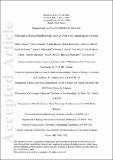Files in this item
Estimates of local biodiversity change over time stand up to scrutiny
Item metadata
| dc.contributor.author | Vellend, Mark | |
| dc.contributor.author | Dornelas, Maria | |
| dc.contributor.author | Baeten, Lander | |
| dc.contributor.author | Beauséjour, Robin | |
| dc.contributor.author | Brown, Carissa D. | |
| dc.contributor.author | De Frenne, Pieter | |
| dc.contributor.author | Elmendorf, Sarah C. | |
| dc.contributor.author | Gotelli, Nicholas J. | |
| dc.contributor.author | Moyes, Faye | |
| dc.contributor.author | Myers-Smith, Isla H. | |
| dc.contributor.author | Magurran, Anne E. | |
| dc.contributor.author | McGill, Brian J. | |
| dc.contributor.author | Shimadzu, Hideyasu | |
| dc.contributor.author | Sievers, Caya | |
| dc.date.accessioned | 2016-11-21T12:30:13Z | |
| dc.date.available | 2016-11-21T12:30:13Z | |
| dc.date.issued | 2017-02 | |
| dc.identifier | 247837696 | |
| dc.identifier | 7b3c385b-d827-4f76-8e36-fa1dda788965 | |
| dc.identifier | 85010378825 | |
| dc.identifier | 000393375700029 | |
| dc.identifier.citation | Vellend , M , Dornelas , M , Baeten , L , Beauséjour , R , Brown , C D , De Frenne , P , Elmendorf , S C , Gotelli , N J , Moyes , F , Myers-Smith , I H , Magurran , A E , McGill , B J , Shimadzu , H & Sievers , C 2017 , ' Estimates of local biodiversity change over time stand up to scrutiny ' , Ecology , vol. 98 , no. 2 , pp. 583-590 . https://doi.org/10.1002/ecy.1660 | en |
| dc.identifier.issn | 1939-9170 | |
| dc.identifier.other | Bibtex: urn:b30da9c6b06059c9df12a070dcbaa7ad | |
| dc.identifier.other | ORCID: /0000-0002-0036-2795/work/43550277 | |
| dc.identifier.other | ORCID: /0000-0001-9687-0593/work/34523492 | |
| dc.identifier.uri | https://hdl.handle.net/10023/9857 | |
| dc.description.abstract | We present new data and analyses revealing fundamental flaws in a critique of two recent meta-analyses of local-scale temporal biodiversity change. First, the conclusion that short-term time series lead to biased estimates of long-term change was based on two errors in the simulations used to support it. Second, the conclusion of negative relationships between temporal biodiversity change and study duration was entirely dependent on unrealistic model assumptions, the use of a subset of data, and inclusion of one outlier data point in one study. Third, the finding of a decline in local biodiversity, after eliminating post-disturbance studies, is not robust to alternative analyses on the original dataset, and is absent in a larger, updated dataset. Finally, the undebatable point – noted in both original papers – that studies in the ecological literature are geographically biased, was used to cast doubt on the conclusion that, outside of areas converted to croplands or asphalt, the distribution of biodiversity trends is centered approximately on zero. Future studies may modify conclusions, but at present, alternative conclusions based on the geographic-bias argument rely on speculation. In sum, the critique raises points of uncertainty typical of all ecological studies, but does not provide an evidence-based alternative interpretation. | |
| dc.format.extent | 8 | |
| dc.format.extent | 649293 | |
| dc.language.iso | eng | |
| dc.relation.ispartof | Ecology | en |
| dc.subject | Biodiversity | en |
| dc.subject | Meta-analysis | en |
| dc.subject | Species richness | en |
| dc.subject | Temporal change | en |
| dc.subject | GE Environmental Sciences | en |
| dc.subject | QH301 Biology | en |
| dc.subject | DAS | en |
| dc.subject.lcc | GE | en |
| dc.subject.lcc | QH301 | en |
| dc.title | Estimates of local biodiversity change over time stand up to scrutiny | en |
| dc.type | Journal article | en |
| dc.contributor.institution | University of St Andrews. School of Biology | en |
| dc.contributor.institution | University of St Andrews. Fish Behaviour and Biodiversity Research Group | en |
| dc.contributor.institution | University of St Andrews. Marine Alliance for Science & Technology Scotland | en |
| dc.contributor.institution | University of St Andrews. Centre for Biological Diversity | en |
| dc.contributor.institution | University of St Andrews. Scottish Oceans Institute | en |
| dc.contributor.institution | University of St Andrews. Institute of Behavioural and Neural Sciences | en |
| dc.contributor.institution | University of St Andrews. St Andrews Sustainability Institute | en |
| dc.contributor.institution | University of St Andrews. Centre for Research into Ecological & Environmental Modelling | en |
| dc.identifier.doi | 10.1002/ecy.1660 | |
| dc.description.status | Peer reviewed | en |
| dc.identifier.url | http://onlinelibrary.wiley.com/doi/10.1002/ecy.1660/suppinfo | en |
This item appears in the following Collection(s)
Items in the St Andrews Research Repository are protected by copyright, with all rights reserved, unless otherwise indicated.

